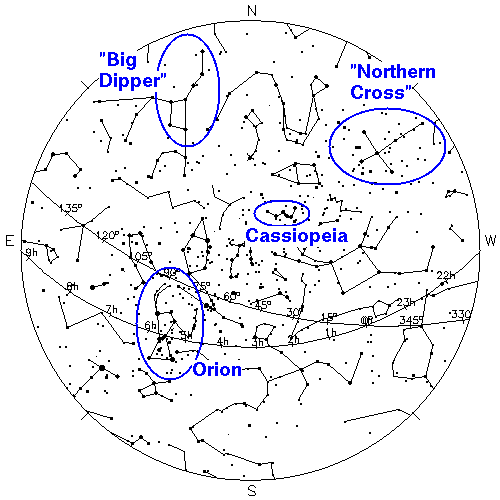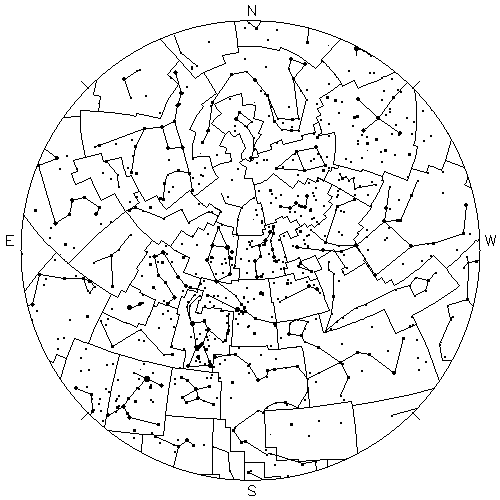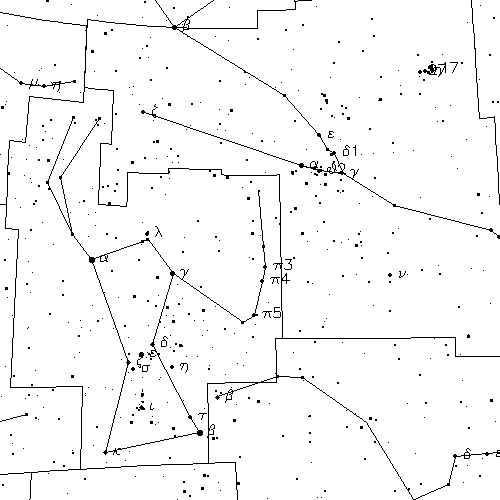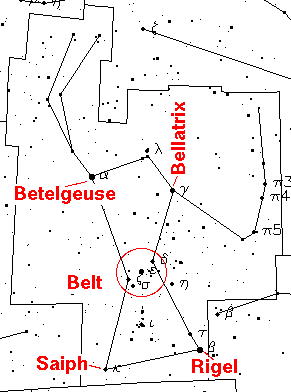

When most people think of constellations they think of connect-the-dots figures (stick figures). For example, the W (or M) of Cassiopeia, the hunter Orion with his shield and raised club, the "Northern Cross" (itself part of the Summer Triangle), and the "Big Dipper": the big spoon in the sky.
Of course, there are no real "patterns" in the sky, rather we see a more or less random array of bright and dim stars. Each culture has taken this "Rorschach ink blot test", and found its own gods, heros and villains enshrined in the sky. In addition to providing cheap, omnipresent monuments for cultural icons, the human constructed "patterns" help cultures encode valuable information about the year: for example, the proper time to plant and reap. Constellations are visual mnemonics to help remember the near random pattern of the sky.
Just as the colonial powers tried to colonize "newly discovered" lands for glory of the nation, astronomers in the colonial states tried to place their own heros and patrons in the stars. This was particularly true for the "newly discovered" southern celestial sphere, but astronomers also needed to fill in small gaps in the traditional constellations. Here is a nice list of obsolete constellations. Some of the more egregious examples are:
The astronomer Lalande, created Custos Messium in 1775, and called it Le Messier, after his friend...Lalande, who passed whole nights on the Pont Neuf in Paris, accosting passers-by and explaining astronomy to anyone who would listen, spent the French Revolution in his observatory and "thanked his stars" for saving him from the guillotine.
...was created by the astronomer Lalande who, having been perplexed by the stars throughout his life, and being very fond of cats, announced that he would now have his joke and let the Cat scratch the "starry chart".(Cats are very fond of sitting on charts which the boss [mistakenly] thinks are more important than the cat.)
Created in 1787 [by Johann Elert Bode] in honor of Frederick II of Prussia, its inventor moved Andromeda's right hand into the position shown on the card in order to make room for it, little caring that her hand had "stretched out there for 3000 years".
Our modern (1928 International Astronomical Union certified) constellations have descended from the ancient Greek culture (which was of course influenced by yet earlier cultures, perhaps going back to 2000 B.C.; see the FAQ). The prominence of the Greek constellations in IAU's constellations is undoubtedly due to the influence of Ptolemy's star catalogue (ca. A.D. 150), which in turn was founded on Hipparchus's (lost) star catalogue (ca. 120 B.C.), but we know these same constellations from earlier work like Aratos's poem Phaenomena (ca. 270 B.C.) and the work of mathematician Eudoxus (ca. 375 B.C.). Click here for a list of the 88 modern and 48 ancient constellations. The added constellations are mostly animals and tools.
Some things we think of as being constellations are really just
parts of constellations or include stars from more than one
constellation. Such groupings of stars are called asterisms.
The Big Dipper is just part of the constellation Ursa Major; The Summer
Triangle spans several constellations, with vertices of
Deneb ( -Cyg),
Altair (
-Cyg),
Altair ( -Aql), and
Vega (
-Aql), and
Vega ( -Lyr). Click
here for a list several well-known
asterisms.
-Lyr). Click
here for a list several well-known
asterisms.
Properly speaking a modern constellation is not a stick figure, rather it is the whole section of the sky that includes the stick figure. The boundaries of the constellations are specified by the IAU; every part of the sky is part of one of the 88 modern constellations.

Here is a closer view of the border between Orion and Taurus:

In sky presentations like the above, we choose to display "negatives" of the sky: instead of bright points of light in a black sky, we display black stars on a white background. While perhaps strange at first, such displays are actually easier to read and to print. The size of the dot representing the star is proportional to the brightness of the star. Hipparchus is usually given the "credit" for inventing the backward system that astronomers use to describe the brightness of stars: the brighter the star the smaller the magnitude. Hipparchus ranked the brightest stars visible to him as magnitude 1 and the dimmest as magnitude 6. Modern definitions of magnitude actually rank the brightest stars with negative magnitudes:
Sirius ( -CMa) -1.46
-CMa) -1.46
Canopus ( -Car) -0.72
-Car) -0.72
Rigil Kentaurus ( -Cen) -0.27
-Cen) -0.27
Arcturus ( -Boo) -0.04
-Boo) -0.04
Vega ( -Lyr) 0.03
-Lyr) 0.03
and of course, today the dimmest recorded stars are limited by telescope time.
A star of magnitude 30 would be considered quite dim. Notice the Bayer
system of naming stars: the brightest star in the constellation Orion is
called  -Ori (a.k.a. Betelgeuse), the second brightest
-Ori (a.k.a. Betelgeuse), the second brightest
 -Ori (a.k.a. Rigel), the third brightest
-Ori (a.k.a. Rigel), the third brightest
 -Ori (a.k.a. Bellatrix, the shoulder opposite
Betelgeuse), where we are working our way through
the Greek alphabet. [Also notice that Bayer reversed the first two: Rigel is brighter
than Betelgeuse, but astronomy is a conservative discipline, so we keep
using the traditional and wrong labels. Note that Ptolemy lists the two
in the correct order.]
-Ori (a.k.a. Bellatrix, the shoulder opposite
Betelgeuse), where we are working our way through
the Greek alphabet. [Also notice that Bayer reversed the first two: Rigel is brighter
than Betelgeuse, but astronomy is a conservative discipline, so we keep
using the traditional and wrong labels. Note that Ptolemy lists the two
in the correct order.]

For more information on the constellations, visit Chris Dolan's home page at UWisconsin.
Author: Warner, Deborah Jean.
Title: The sky explored : celestial cartography, 1500-1800
/ Deborah J. Warner.
Publisher: New York : A. R. Liss, c1979.
Author: Tennant, Catherine
Title: The Box of Stars : A Practical Guide to the Night Sky and
to Its Myths and Legends/Book, Cards and Maps/Boxed Set
/ Catherine Tennant
Publisher: Bulfinch Press, c1993